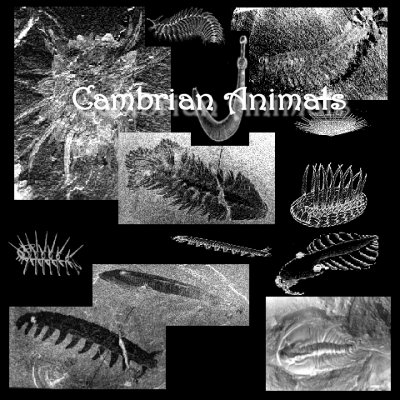|
|
||
|
|
|
|
| Most major animal groups appear for the first time in the fossil record some 545 million years ago in a relatively short period of time known as the Cambrian explosion. Of great worry to Darwin, the explanation of this sudden, apparent explosion persists today as a shadowy mystery. While some scientists believe there was indeed an explosion of diversity (the so-called punctuated equilibrium theory elaborated by the late Stephen J Gould - Models In Paleobiology, 1972), others believe that such rapid acceleration of evolution is not possible; they posit that there was an extended period of evolutionary progression of all the animal groups, the evidence for which is lost in scanty fossil record. The theory of the Cambrian Explosion holds that, beginning some 545 million years ago, an explosion of diversity led to the appearance over a relatively short period of 5 million to 10 million years of a huge number of complex, multi-celled organisms. Moreover, this burst of animal forms led to most of the major animal groups we know today, every extant Phylum. It is also postulated that many forms appeared that would rightfully deserve the rank of Phylum, both appeared in the Cambrian, and subsequently, rapidly disappeared. Natural selection in many cases favored larger size, for example, hard skeletons to provide structural support - hence, the Cambrian gave rise to the first shelly animals and animals with exoskeletons (e.g., the trilobites), and the size of many animals "exploded". If,
in fact, the Cambrian Explosion is true, environmental factors
probably were prominent in defining the selective pressures
leading to diversification on a vast The
debate about whether the evolutionary "explosion"
of the Cambrian was as sudden and spontaneous as it appears
persists today. The discovery of new pre-Cambrian and Cambrian
fossils help, as these transitional forms support the hypothesis
that diversification was well underway before the Cambrian began.
More recently, the sequencing of the genomes of thousands of
life forms is revealing just how many genes and the proteins
they encode have been conserved from the Precambrian. The explosion
of external form in the fossil record is what we see, but more
gradual adaptation was taking place at the molecular level. Among the famous Lagerstatte of Cambrian time, the Burgess Shale of Canada and Chengjiang, in Yunnan Province, China are the best known, having a great diversity of benthic or burrowing creatures. Less well known is our own state of Utah where similar Cambrian forms are found. If fact, a larger number of species to be found in the Wheeler and Marjum Formations of Utah than the Burgess Shale, though the fossils are far less abundant. The link below allows viewing of some of these intriguing Cambrian fossils. |

 scale. By the start of the Cambrian, a large supercontinent
comprising all land on Earth was breaking up into smaller land
masses. This increased the area of continental shelf and produced
shallow seas, and a diversity of environments in which animals
could specialize.
scale. By the start of the Cambrian, a large supercontinent
comprising all land on Earth was breaking up into smaller land
masses. This increased the area of continental shelf and produced
shallow seas, and a diversity of environments in which animals
could specialize.